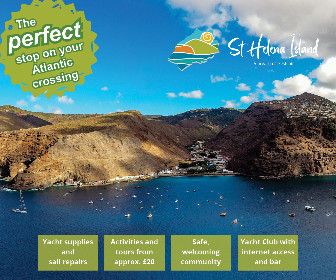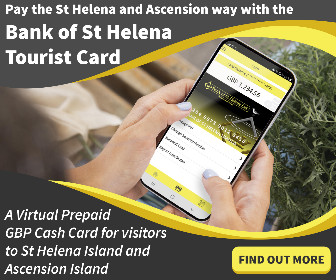Indian Ocean Crossing: A tough route, but well worth it!
After leaving Australia, Swedish cruisers Anna and Arthur Eriksson took the southern route to South Africa via Christmas Island, Cocos Keeling, Rodrigues, Mauritius and Reunion. It was a testing route for them, but well worth the effort as they recount in this report for Noonsite.
Published 3 months ago, updated 2 months ago
With the Indian Ocean behind us I want to share with Noonsite readers what an exciting route this was, although I am very happy to have done it with safety and harmony on board, especially as it is a route that many fear.
The Indian Ocean is a huge ocean between three continents – Australia, Asia and Africa. The many islands provide a lot of choices and make the journey easy to manage in a number of steps. Finally arriving at the Cape Peninsula in South Africa is amazing. This area is one of the new seven wonders in the world.
The Southern Route
We took the southern route from Darwin, Australia with stops at Christmas Island, Cocos Keeling, Rodrigues, Mauritius and Reunion, before entering South Africa in Richards Bay. The distance of 5664 nautical miles took us three months from the end of July to end of October 2023, with a total of 39 days at sea.
The coastal sailing from Richards Bay to Cape Town, another 986 nm, took us three weeks via Durban, Port Elizabeth, Mossel Bay and Hout Bay. We arrived in Cape Town on 6 January 2024, the same day World ARC left.
Stopovers
Darwin, Australia: Confirm an appointment time with Customs and meet them in Cullen Bay Marina for checking out. If you have bought boat stuff and diesel, you can get the tax back. Customs verify your receipts.
Christmas Island: There is food to buy, more expensive, but on the other hand the alcohol is tax-free and the mooring cheap. It’s a beautiful island with blowholes, crabs, birds and beaches. Mooring buoys must be used in Flying Fish Cove. Easy access – even at night time. Easy check-in and check-out, just call them on the VHF. There seems to be a shortage of rental cars. Pre-book via the tourist office, or your may be able to get a local to take you around. If you need diesel, it is easier to get it here than at Cocos Keeling. The petrol station will pick you up and fill your jerrycans for you.
Cocos Keeling: Day time entry is recommended at Direction Island, because there are lots of corals and the entrance is a bit confusing. Customs will come and meet you. Payment, food shop and diesel at Home Island, a dinghy ride between coral heads. The shop had a lot of frozen meat and it was possible to pre-order eggs. It was blowing a gale when we were there, so we had to wait for a weather window to leave.
Between Cocos Keeling and Rodrigues the Indian Ocean will build up her forces. The wind was a constant 20-30 knots and the waves on our port side increased to 4-5 meters. Make sure you have a full gas bottle prior to this part of the passage, so you don’t need to open the stern compartment underway to change it!
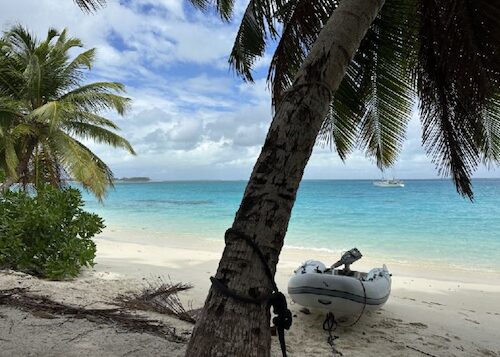

Rodrigues: A small island, the first African one. Anchoring in Port Mathurin. Customs come and meet you and then you do the rest of the paperwork on land. There is an extra charge if you leave on a Sunday. Great local market every Saturday.
Mauritius: Reserve a place in the small marina in Port Louis. The check in takes time and they search through your boat. If you have medicine they want to see the receipts. Port Louis is a big city, very fancy around the marina. They have a huge marketplace for vegetables, fruit, fish, meat and poultry within walking distance. Many stay on anchor at Grand Bay, but there is a ground threashold, so we didn’t.
Reunion: A very French island, clean with everything in order. Here you wait for a weather window to Richards Bay and stock up on French cheeses, sausages and wine. Hire a car or take one of the local buses up to the mountains.
For Reunion to South Africa, Captain Arthur’s weather tactics was to use Iridium-Go and Predict Wind. Look for several high pressures south of Cape Town – they usually give a rather stable pattern of good weather east of South Africa. This is not to say there will not be very gusty depressions from the south – they will come anyway.
Sailing to South Africa
The sailing to Richards Bay, 1400 nm, will take about 8-12 days. It takes around four days down to the southern tip of Madagascar, keeping well out from the coast. The tricky part is to pass over the Mozambique Channel including the southbound Agulhas current – the wind has to come from the north too, if not, the waves can be very high. The wind shifts between north and south every second to fourth day and the shift comes very fast. The escape plan is to follow the wind north until it turns south again, then it’s time to cross over. We had all kinds of winds and weather on this trip, even thunder and no wind at all.
South Africa
Richards Bay: Most people make Richards Bay their point of arrival. It’s well organized and Zululand Yacht Club is a small and friendly marina that takes good care of their guests. OSASA, a voluntary organization set up during Covid, helps with arranging meetings with Health officials who will come to you at the quarantine dock.
In Africa you take a car wherever you go. You rent one, use an Uber or their local version Bolt. Zululand Yacht Club has their own man, Eric, who takes you around to Customs and the shopping mall for food and to buy a wifi/telephone card.
At Zululand it was easy and cheap to get help with all kinds of boat cleaning. It’s also a place where you can lift the boat, get bottom paint and so on. Diesel is available and it is possible to refill all types of gas bottles. Sail repairs happens in Durban and Cape Town, over priced in our opinion. The game reserves are close, only a few hours drive away and it is very cheap to eat out.
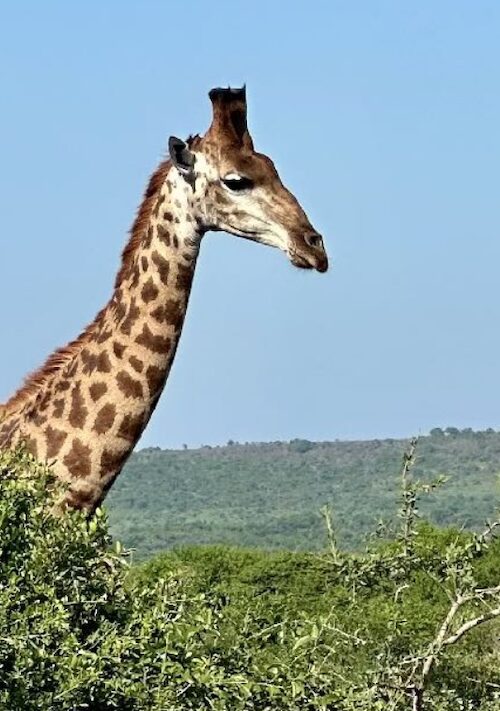

Coastal Sailing to Cape Town
Nearly 1000 nm, for this passage it is necessary to go with northerly winds. That means taking it in steps, some days at a time and taking advantage of the current. Talk to and learn from the local sailors in South Africa.
The harbors to count on during the way down are: Durban, East London (in a river), Port Elizabeth, Knysna, Mossel Bay and Hout Bay. We didn’t stay in Knysna, one can only go in and out at high-water, but several who did said it was very beautiful.
In Cape Town you can either stay at the Waterfront Marina in the city center, or at the Royal Yacht Club which is a bit outside the city, but closer to the marine chandlers.
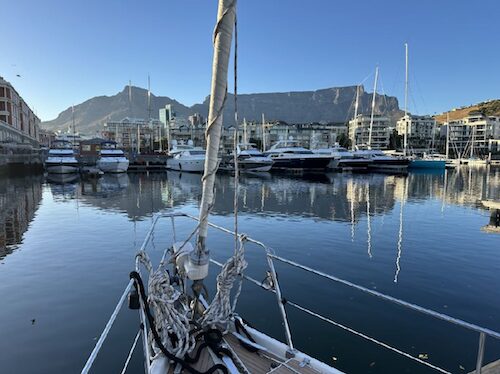

We chose to stay in Hout Bay for some weeks before going around the corner to Cape Town. It’s South Africa’s biggest fishing marina, surrounded by mountains. It’s very windy though, but the beauty and closeness to a big beach and the small town overrides that.
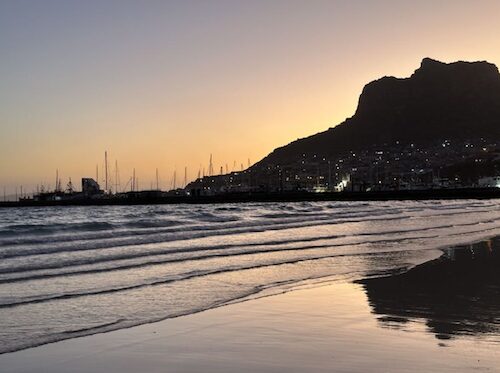

Many vineyards and the Kirstenbosch Botanical Garden is nearby. In our opinion the wines are better, not so sweet, in South Africa than New Zealand and Australia.
South Africa Highlights
Coming to Africa was a reminder of our origins. Many of our most common flowers come from the floral kingdom at Cape Peninsula, the smallest but richest in species, of the worlds six floral kingdoms. It was also great to see wild animals in their own habitat. A visit to Table Mountain, close to Cape Town, is a must. Go as early as possible in the morning as queues quickly build up.
Lessons Learned from our Indian Ocean Crossing:
- Don’t be put off by the ones who point out how difficult it is. Many have made this trip. Learn from them and be prepared.
- Go in the right season, May to November.
- A boat built for ocean sailing helps make the trip safe and comfortable – having double autopilots, watermaker, generator and center cockpit from where you can reef are also advantageous.
- Be careful and watch the weather constantly. Reef early.
- Hire a car and visit a game reserve when you are in Richards Bay. Book a room inside the park, as the best time is early morning from 5 AM.
- Take time for the South Africa coastal sailing.
Fair winds
Anna and Arthur Eriksson
SY Vista, an Amel Supermaramu 53 foot ketch.
Follow their adventures at:
Other Articles by Anna on Noonsite:
- South Africa: Checking out of Cape Town (January 2024)
- INSIGHTS: Cruising with the Moon (April 2021)
- INSIGHTS: Pacific Reflections (October 2020)
…………………………………
The opinions expressed in this article are the author’s own and do not reflect the view of Noonsite.com or World Cruising.
…………………………………
Find out all news, reports, links and comments posted on Noonsite, plus cruising information from around the world, by subscribing to our FREE monthly newsletter. Go to https://www.noonsite.com/newsletter/.
Related to following destinations: Australia, Cape Town (Table Bay), Christmas Island, Cocos Keeling, Darwin, Direction Island (South Keeling), Durban, East London, Flying Fish Cove, Home Island, Hout Bay, îles Eparses (Scattered Islands), Knysna, Mauritius, Mauritius, Mossel Bay, Northern Territory (Australia), Pointe des Galets (Le Port), Port Elizabeth, Port Louis (Mauritius), Port Mathurin, Reunion Island, Richards Bay, Rodrigues, Saint Gilles les Bains, Saint-Pierre, South Africa
Related to the following Cruising Resources: Indian Ocean, Routing


